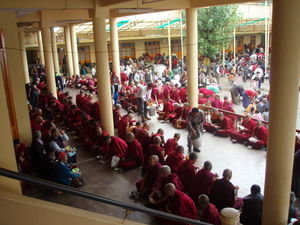Advertisement
Published: October 2nd 2007

 McLeod Ganj
McLeod Ganj
buddhist monks "at work"We spent one last night in Srinigar before departing on a long and convoluted journey to a small area in the mountains in Himachal Pradesh, called McLeod Ganj (about 10kms outside of Dharamsala).
McLeod Ganj is the home of the Tibetan government in exile and of the Dalai Lama, although he wasn't there for our stay. It has a largely Tibetan population and is like a different country altogether. There were also a lot of tourists, which was strange because we had encountered so few up to that point. It is situated on the edge of a mountain and is covered in pine trees and would have been very scenic had it not been for the constant blanket of clouds that hangs over the town. Although that was picturesque in its own way.
We stayed in a really nice little apartment with a balcony that looked out onto the mountain range (and was only 2e a night!). It had an amazing restaraunt (probably the best we have come across) that served home made pasta- a very welcomed alternative to rice!
We spent the first day eating and shopping and were delighted to find that you do not get nearly as much hassle from the market sellers as we had in other places. We bought a few bits and pieces and i got a gorgeous wall-hanging and some jewellery.
On day two, we visited the "Tsuglagkhang complex", which houses the home of the Dalai Lama, a Buddhist temple and a Tibetan museum. It was a really scerene place, despite the crowds and it was strange to see the hundreds of monks doing their thing. The temple was also strange because, although it wasn't an elaborate structure, it was decorated very over-the-top and had a massive and intricate mural hand-painted and covering every wall from floor to ceiling. The Buddhist pilgrims offer food to the Gods and there was one room absolutely filled with piles of food that gets left before each statue and changed regularly. The museum was really moving and used photos and video clips to show the suffering and oppresion that the Tibetan people have experienced at the hands of the Chinese Maoists. It was very emotional because there were a lot of beggars in the town (more than anywhere else we have been thus far) and, many of them had physical disabilities that the museum attributed to torture and frostbite (they flee Tibet on foot and walk hundreds of miles over the Himalayas for sanctuary). It was hard walking past them after that, knowing what we had learned.
The following day we attempted to hike (the Lonely Planet calls it a "gentle stroll") up to a waterfall but only made it as far as a local village ('Bhagsu') and ended up people-watching in a little cafe! That night we went to a very strange Sufi concert, which appeared to have been a musical attempt at converting the audience! A lot of people seemed to fall for it so we left half way in search of a pub! That said, the music was alright...
We tried Tibetan traditional food, which is surprisingly very unlike Indian or Chinese and was quite nice (especially 'momos'- fired dumplings, stuffed with cheese and veg) and, we ate like kings for the three days.
Overall, it was well worth the traumatic commute to reach the town and the three days were the most relaxing we've had so far. We would have spent longer there had it not been for our pre-booked train to Delhi in a weeks time but, that said, it was good to leave on a high.
Next stop- Punjab and the Golden Temple...
Advertisement
Tot: 0.069s; Tpl: 0.01s; cc: 9; qc: 47; dbt: 0.0462s; 1; m:domysql w:travelblog (10.17.0.13); sld: 1;
; mem: 1.1mb

 McLeod Ganj
McLeod Ganj